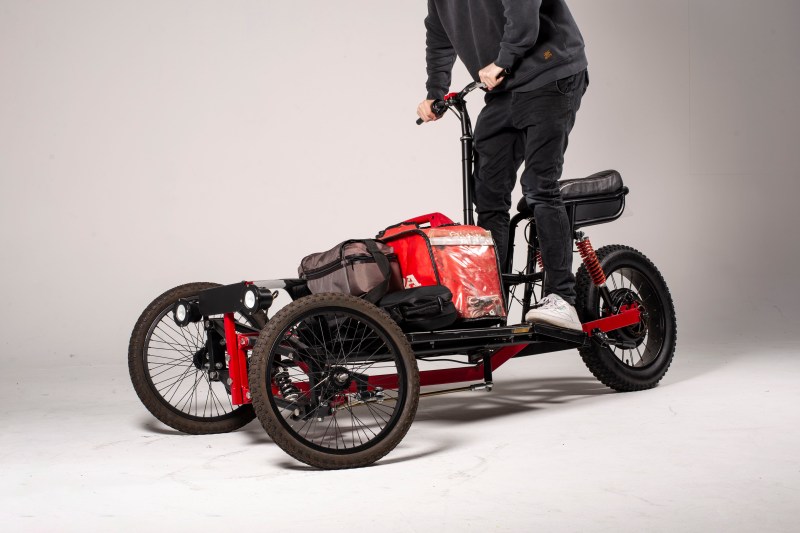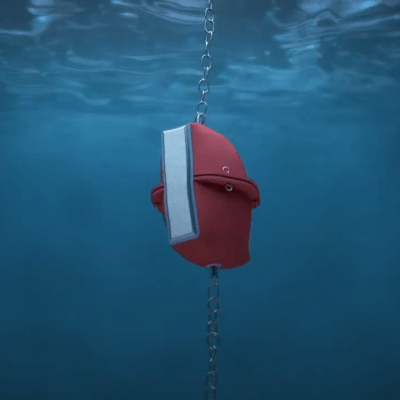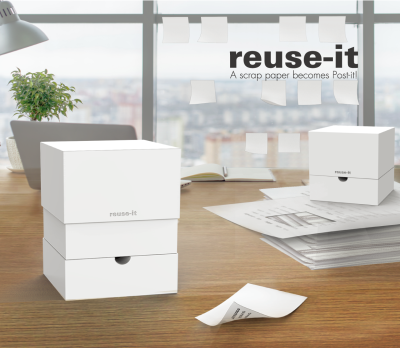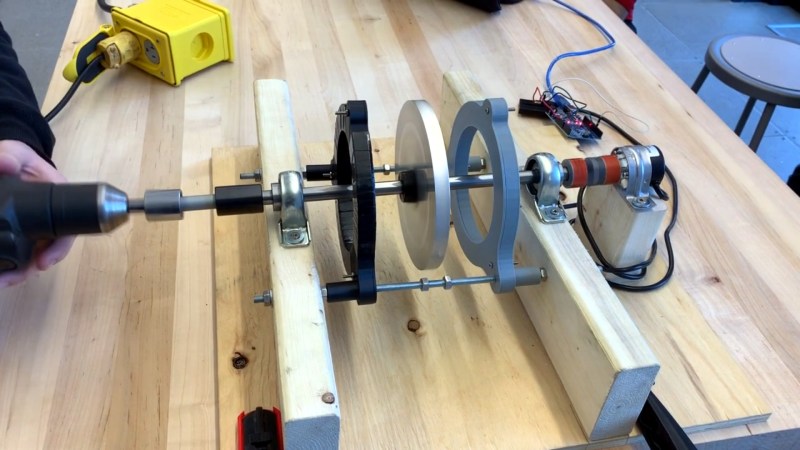Named after British inventor James Dyson of cyclonic vacuum cleaner fame, the Dyson Awards are presented annually to current and recent students of engineering, industrial design, and product design, regardless of age. Students from 27 countries work alone or in groups to describe their inventions, which are then judged for their inventiveness, the production feasibility of their design, and the overall strength of the entry itself.
Much like our own Hackaday Prize, the Dyson Awards encourage and highlight innovation in all areas of science and technology. Some ideas help the suffering individual, and others seek to cure the big problems that affect everyone, like the microplastics choking the oceans. The Hackaday spirit is alive and well in these entries and we spotted at least one Hackaday prize alum — [Amitabh]’s Programmable Air. I had fun browsing through everything on offer, and you will too. This is a pretty good source of design inspiration.
Electric Cargo Trike

What’s the bottleneck of any delivery system? The last mile, the local loop. Long distance used to cost a fortune because Ma Bell had to pay to run tip and ring out to every farm that wanted a phone line, and that wasn’t cheap. Reverse the problem, and you have delivery trucks of all stripes clogging the urban cores, their flashers blinking in steady robotic apology.
Smaller delivery vehicles are on the rise in New Zealand, but they are slow, a bit unsafe, and handle terribly. Electric Cargo Trike was inspired by tilting sport bikes and has a pivoting shock mount that keeps the front wheels parallel no matter what. The independent three-wheel suspension protects the driver and the goods from speed bumps and other obstacles of the city. This video shows the team’s entire design process from LEGO mock-ups, to bike part prototypes, to final version, which has a 48V, 1000W motor.
 MarinaTex
MarinaTex
Plastic, once revered for its versatility, has become a discarded six-pack ring that’s choking the environment. While reusable plastic still has its merits, too many applications involve single-use plastics that take eons to biodegrade. MarinaTex is designed to replace single-use plastics in things like the windowed bakery boxes and sandwich wrappers.
MarinaTex is a bioplastic made from a mix of red algae and waste from the fishing industry. Unlike other bioplastics, MarinaTex doesn’t need high heat to biodegrade — it will break down in 4-6 weeks inside a home composter.
Inventor [Lucy Hughes] was looking into ways to reduce waste in the fishing industry, which produces 50 million tons each year. By leveraging the ocean’s own garbage, MarinaTex inspires us to think cyclically when designing things. In other words, one industry’s trash is another industry’s raw material.
 Self-Regenerating Rubber Pavement
Self-Regenerating Rubber Pavement
Some of the best inventions stem from making lemonade from the lemons of life. Roads get weaker every time it rains? Time to design a pavement material that uses rainwater to regenerate itself.
The pavement was inspired by concrete that heals itself using bacteria that lies dormant in the mix, waiting for a crack that lets rainwater in.
As rainwater trickles toward the bottom layers of the pavement mixture, it encounters a putty made from old tire rubber and secret additives. The water activates the putty and creates calcium silicates that expand, fortifying the asphalt and making the roads safe from suddenly sinking.
 ANT Container System
ANT Container System
As container ships get larger and larger, the bottlenecks caused by unloading them at established harbors get worse and worse. The ANT system is designed to autonomously unload ships and whisk the containers away.
Using a system of smart, moveable gantries, the ANT container system can pluck containers directly from a ship and either stack them on the dock in a game of robotic 3D Tetris, or deliver them to a nearby warehouse on overhead rails.
The ANT system eliminates the need for many pieces of specialized equipment currently used to pick and place containers. It’s completely modular, so it can be adapted to any existing harbor configuration.
 YUNA Filtering Buoy
YUNA Filtering Buoy
Once upon a time, if an industry needed a gentle abrasive in their product, they used something innocent like pumice or pulverized almonds. Now they are more likely to use microbeads, aka the primary source of ocean-clogging microplastics.
YUNA is submerged buoy that filters the tiniest of microplastics through stages of successively smaller granules of filtering media and captures it for re-use. It moves with the changing sea currents to filter as much microplastic as possible. The ultimate goal is to recycle microplastics by blending them with melted-down plastic bottle caps to create new objects.
 Reuse-It
Reuse-It
The sticky note is a simple idea that’s well-executed. The only problem is that even though they are largely made from recycled paper, buying and using them still creates waste.
The makers of Reuse-it have a simple plan: make your own sticky notes from the raw material of your office recycling box. The only way it could be more useful is if it could somehow turn those TPS reports into halfway decent coffee.
Just open the lid and insert the scrap paper, clean side up. Push down on the top, and Reuse-it cuts out a small piece and applies adhesive to the backside in one step.
 Cocoon
Cocoon
Most epileptics sense when a seizure is coming on. It’s a normal part of epilepsy that can happen anywhere, anytime. When it does, it’s important that they lay on their side with a cushion underneath their head. If the seizure lasts more than five minutes, they need an ambulance. No matter how long it lasts, someone needs to reorient them once the seizure is over.
Cocoon is a portable safe space that does much more than cushion the head. Sensors detect the convulsions and alert a caretaker immediately, giving them GPS coordinates. A pocket made of stretchy mesh keeps the head on the cushion throughout the convulsions. At three minutes, Cocoon calls an ambulance, but will abort the call and alert the caretaker if it senses the patient is no longer laying down.
 Aeroflux Contact-less Brakes
Aeroflux Contact-less Brakes
One of the biggest sources of waste in aeronautics are the brake pads. On commercial planes, they last a year at most. Airplane brakes are a lot like the ones on your car — friction-based dampers that actively grind against the rotors and get eaten up in the process.
Trains, on the other hand, have eddy current braking systems that use opposing magnetic fields to slow the roll. These friction-less brakes would be ideal for planes, except they require enormous electromagnets that weigh a ton. Aeroflux contact-less brakes use a distributed magnetic field designed to maximize eddy currents, bringing planes to a stop quickly and effectively.
But Wait, There’s More
The national winners and runners-up from each country were announced on September 19th. But there’s still one grand prize winner yet to be announced who stands to win $35,000, plus another $5,500 for their university. Check the Dyson Awards site November 14th to see the winner, chosen by Sir James Dyson himself. That happens to be just two days before we announce the grand prize winner of the 2019 Hackaday Prize live from Supercon on November 16th at — follow along on our YouTube channel broadcast of the ceremony beginning at 7pm Pacific time (UTC-8).















“AEROFLUX CONTACT-LESS BRAKES” I think the kid (Nikola Kostic) going to University of Toronto whos working on this must have fell asleep in class to many times. Yes this does work, but to stop the energy of a heavy object like a plane the rotors would need to be like 1/2 the size of the plane itself.
And on top of that, you still need friction brakes to prevent movement. Trains still use brake shoes.
And to complain about more things (because I am at work wasting time) – The Yuna Filtering buoy will end up filtering (and getting clogged with) all sorts of biological material including plankton.
I would guess the math does not work out, because no one is doing it…
But I always taught it would be cool to put some permanent magnet synchronous motors in the landing gears.
Then on landing regenerative brake into a battery pack (I am not sure how much energy you would recover, especially with the thrust reversers running).
Use the battery pack to taxi around the airport (fire up the auxiliary power unit, if/when the battery pack gets low).
I may have read about it here on HaD, but aircraft already have a pretty ingenious braking system.
(yeah, I’ve forgotten details…)
The anti-lock system in a big heavy aircraft landing gear has to be spot on, because there’s so much mass to brake down from such high speeds that if you lock up the brakes the tires just vanish, and then the plane faceplants on the runway.
Eddy current brakes are “nice” in the sense that they behave in a predictable fashion compared to friction brakes. If the wheel speed is zero, the braking torque is zero, so they can’t lock up – they can take the first bite out of the landing event and provide braking torque before you actually cut the friction brakes in.
>” regenerative brake into a battery pack”
That’s not a feasible idea for a simple reason: eddy current brakes work with low voltages and extremely high currents over short loop paths. The whole reason it works and produces a meaningful amount of braking torque is because you’ve got an inch-thick slab of copper that can conduct something like a hundred thousands amps in a short circuit within itself.
If you cut the eddy loop and diver the current to a battery somewhere far away, you increase the loop impedance and the current that can form in it collapses to a few amps – the braking torque vanishes.
This would need a battery that could accept a charge in, I guess about 60 seconds and would this be saving much in fuel given the plane has to carry those batteries everywhere.
A 747 weighs around 400 tonne at take off but much less at landing. Still, landing weight ain’t gonna be light weight so all up maybe the brakes they use ain’t that bad.
It seems like a depressingly regular feature of “innovative tech awards” that no-one actually does the math to prove whether a col idea is actually a feasible product.
Remember the green design prize that was given to a lamp that was powered by a big counterweight falling? They said it would run a normal LED lightbulb for four hours, ignoring the fact that the counterweight would need to weigh one and a half tons to perform as well as they claimed. https://www.wired.com/2008/02/gravity-powered/
Actually eddy current brakes work way better than you think they would. Even very small ones. I used to rebuild aircraft actuators and servos (among other things) when I was in the Marine Corps. One of which had a small aluminum disk about 2.5″ in diameter with a permanent magnet. When the magnet was installed it took twice as much force to move the arm back and forth. Also it’s a lot easier to stop something with traditional braking systems that’s going 60MPH vs 400MPH. So bringing the plane to a total stop with an eddy current brake isn’t a strict requirement for feasibility.
Also, eddy current brakes are naturally anti-locking.
I can’t see why mike thinks it would have to be so large – it all depends on strength of magnetic field, relative speed and properties of the material. Of course the energy dissipated has to go somewhere but that’s no different from normal brake pads, and same cooling solutions will work.
Friction brakes can lose a lot of heat because they can get hot enough to drive the heat through the thermal impedance of the medium (air?).
AFAIK Cu melting temp (about 3000DegC) is well below brake temperatures (iron, red hot, really high temp but I forgot it :/ )
In any event, if the permanent magnets warm up at all then the breaking stops but the plane does not. And the magnets will warm to some degree I think.
>”MarinaTex”
https://phys.org/news/2019-11-simulated-sunlight-reveals-plastics-sea.html
“Simulated sunlight reveals how 98% of plastics at sea go missing each year”
TL;DR: Most plastics are broken down within 2.7 – 4.3 years in the ocean. The most resilient plastics are PP and PE which can hang around for 40 years, but the rest are pretty much broken down by UV light and eaten by bacteria.
The irony is that bio-degradeable plastics don’t readily degrade in sealed land fill or compost piles, due to lack of UV light breaking down the polymers.
Correction, polypropylene (PP) doesn’t last for 40+ years, but 4 years.
Polyethylene (PE) like in milk jugs and bottle caps has the longest environmental half-life. This is what makes grocery bags a problem, because they’re most often made of LDPE and HDPE.
So your advocating no change in our plastic use?
And yes current “bio-degradable” plastics need special conditions to break down, that’s what makes marinated exciting to me. Since you missed it
“MarinaTex doesn’t need high heat to biodegrade — it will break down in 4-6 weeks inside a home composter”
Well, find an alternative for PE plastics and some other nasties like PVC and PTFE, and the problem of plastics largely goes away. Most of the rest of the plastics break down in comparable time as e.g. a piece of wood.
The problem of highly biodegradable plastics is that they break down while in use. At one point they tried to make shopping bags out of PLA and PCL, but they started rotting on the pallet in the warehouse as soon as they got a little bit of moisture. They’re not very suitable for food packaging or structural plastics, since mold can attack them – they’re pretty much only good for throw-away product packaging, which is a waste of plastics in the first place.
Its funny that in order to get rid of plastics we feel we must invent something new. But it’s arleady been invented. Its’ what palstic replaced.
Like paperbags, cardboard boxes, wax paper, glass bottles, bring your own container, old news papers for wrapping fish, etc etc…
funily enough Im in the process of fixing a dyson vacuum cleaner for my brother – what a piece of gimmicky fiddly POS. Designed by some one who has never used a vacuum cleaner.
Built to be mass produced at the lowest possible cost and sold at an insane price.
The vacuum cleaner I think is insanely priced, is the red one with eyes painted on it.
It’s like they charge over $100 (or equivalent currency) just to paint each eye on a ShopVac!
> MarinaTex doesn’t need high heat to biodegrade — it will break down in 4-6 weeks inside a home composter
Break down into what?
Mercury, radium, and nerve gas.
Some pretty interesting projects there. This seems like a strange mashup of startup companies, university research, and school science fair type projects. It looks like a lot of work went into presentation on these and in some cases more work coming up with the idea being presented.
The Hero photo at the top of the article (yes the one with no explanation or alt-text) is the contact-less brakes test rig.
https://vimeo.com/347192905
It’s still pretty feeble as a brake. If you press your finger on a disc like that, it stops in milliseconds because there’s just no energy stored in it.
Taking several seconds to brake down means you have a braking torque of some millinewton-meters. For a system of that scale, that’s terrible.
“The Dyson Awards Definitely Do Not Suck”
“delivery trucks of all stripes clogging the urban cores, their flashers blinking in steady robotic apology”
“Plastic, once revered for its versatility, has become a discarded six-pack ring that’s choking the environment. ”
… brilliant.
Whaever HaD is paying you, it’s simply not enough.
Aw, shucks. Thank you!
The Cocoon seizure device is a good idea. However it’s important to note that in many states (possibly countries) it’s illegal to attempt to call off or cancel an emergency response. There’s no outright punishment other than maybe an earful from your local fire marshal or similar, but bear in mind that if the Cocoon tries to cancel a call, depending on were you live, you may have an additional problem on your hands. If you attempt it in NH, the first time around you’ll get the aforementioned earful, but do it repeatedly and you could be looking at a fine.
I should have added that that does not apply to commercial EMTs, but to municipally operated emergency services. IE a municipal fire department that also operates an ambulance.
That ANT Container system seems pretty neat. I wonder what a huge network of those would look like.
I feel like rotating the containers could use a lot of time/energy and/or create a lot of stress. Just a gutt feeling though watching the video
The ANT idea doesn’t really seem al that feasible to me. A lot of large container ports already use autonomous portal cranes for the lifting work, transport is done by Automated Guided Vehicles. The only the the ANT system eliminates is the AGVs, at the cost of creating costly raised track infrastructure for them to run on. Maintenance is also more difficult (since they are above the ground). The idea is nice in theory, but I don’t think it will work in practice over the currently used system of portal cranes and AGVs.
These are all cooler than I expected from Dyson! I don’t know how practical some of them are though.
As an epileptic, I’m not terribly thrilled with the “Cocoon”. Who would be there to put it onto a seizing patient? The article states that “most” epileptics can tell when a seizure is coming on. I guess I’m an oddball then, because none of my seizures has ever come with such a remarkably convenient warning. Could have saved me from having a couple of rather embarrassing moments in my life.
Maybe it would work for some people, but doesn’t seem like a useful device for this oddball epileptic.
The characterization of Ma Bell charging high long distance rates for the Universal Service Fund is just plain wrong. They overcharged because they were a monopoly. The USF charge is and has been a separate line item paid for directly by the customer! Look at a landline phone bill! (There are still some around…)
The ANT system solves the wrong problem. The real problem is that there are huge container ships carting disposable junk all over the planet. That’s the problem that needs to be solved.
Not to mention cargo ships use the nastiest sludge that is left over after all the good stuff is refined out of oil. What’s left – “bunker fuel” – is what they burn and belch out into the atmosphere. They have to run steam lines through the tanks to get the sludge hot before it will even flow!